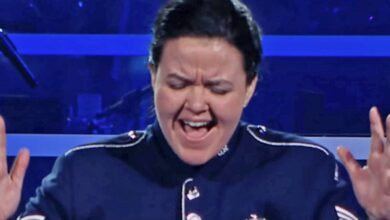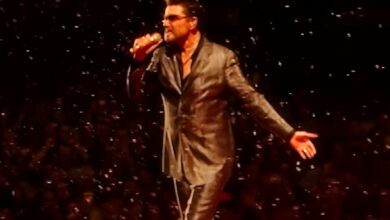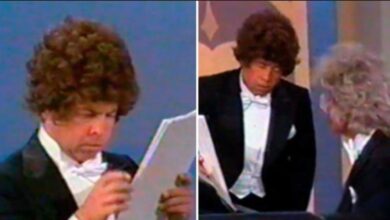Tom Jones’s “Delilah” Turns a Dark Murder Ballad into a Global Sing-Along and Sweeps the Charts in 1968
The opening trumpet flourish of “Delilah” hit British radio in February 1968 like the first gasp of a stage curtain, revealing a tale of jealousy, betrayal, and sudden violence that somehow still begged listeners to clap along. Within weeks Tom Jones’s dramatic single had raced up the UK Singles Chart, stalling only at No. 2 yet outselling many No. 1s and quickly passing the coveted million-copy mark worldwide. In an era when pop lyricists usually chased teen romance or psychedelic whimsy, Jones brought a full-throated operatic waltz about a fatal crime of passion into living rooms from Cardiff to Canberra, proving that even the darkest storyline could become an arena-wide anthem if delivered with enough bravado.
Tom Jones himself was already a formidable presence by then. Born Thomas John Woodward in the coal-mining town of Pontypridd, Wales, he honed his colossal baritone singing in local pubs before Decca Records spotted him in 1964. Hits such as “It’s Not Unusual” and “What’s New Pussycat?” showcased a charismatic showman who balanced Vegas swagger with working-class sincerity. Yet it was his gift for inhabiting story songs—projecting every ounce of drama through vocal firepower—that separated him from the British Invasion’s guitar-slinging frontmen and positioned him to tackle a composition as theatrical as “Delilah.”
The song’s roots lay with English songwriters Les Reed and Barry Mason, who claimed inspiration struck after seeing a flamenco act in a dim London club. Reed hammered out a minor-key melody steeped in Spanish flourish, while Mason penned lyrics about a scorned lover who stabs the woman who betrayed him. They titled it “Delilah” after the biblical temptress, sealing its fateful tone. When Jones first heard their demo—reportedly played on a portable tape recorder backstage at a variety show—he leapt to his feet, convinced he’d found material worthy of his booming vibrato and flair for melodrama.
Producer Peter Sullivan booked Decca’s West Hampstead studios in December 1967 and built the track around a martial snare, mariachi-style trumpets, and a full string section that swelled like a tragic opera. Jones recorded his vocal in two explosive takes, modulating from intimate hurt in the verses to thunderous power on the chorus, punctuated by sharp horn stabs that mimicked the fatal knife thrust of the narrative. The final mix ran just over three minutes, yet every second felt like a miniature movie—raw, concise, and impossible to ignore on AM radio.
Upon release, “Delilah” stormed charts across Europe, topping lists in Germany, the Netherlands, Switzerland, and Australia while climbing to No. 15 on the U.S. Billboard Hot 100—no small feat for a waltz-time murder ballad during America’s psychedelic peak. Critics lauded its boldness, and the songwriters collected the 1968 Ivor Novello Award for Best Song Musically and Lyrically. Even listeners who blushed at the storyline couldn’t resist its soaring hook, and jukebox operators reported that patrons were happy to spend an extra dime just to bellow the chorus in unison over pints of lager.
Culturally, “Delilah” nudged mainstream pop toward more cinematic narratives, suggesting audiences were ready for songs that read like short films rather than diary entries. Its success emboldened labels to green-light other dramatic story songs—think Cher’s “Gypsies, Tramps and Thieves” or Tony Christie’s “Is This the Way to Amarillo”—and reminded producers that a strong singer could turn even grisly subject matter into commercial gold. For Welsh listeners, it also served as a point of national pride: here was a valley boy commanding global airwaves with a voice as big as the mountains surrounding Pontypridd.
Professionally, the single supercharged Jones’s already ascending career. Bookings at London’s Talk of the Town extended into a transatlantic residency at Caesar’s Palace, where “Delilah” became his dramatic show-stopper, complete with swirling spotlights and a climactic stab of horns that left audiences roaring for encores. It helped secure the launch of his weekly television variety program, “This Is Tom Jones,” in 1969, granting him entrée to American living rooms and pairing him on-screen with icons from Aretha Franklin to Janis Joplin—all eager to duet with the man who could make a murder ballad soar.
Within the wider industry, the song’s waltz rhythm and trumpets sparked a brief vogue for Latin-flavored pop arrangements in the UK, while its vivid plot inspired writers to revisit the centuries-old tradition of the tragic ballad in a modern, radio-friendly format. Aspiring crooners studied Jones’s theatrical phrasing, realizing that technical power mattered less than the ability to inhabit a character and drive a narrative straight through the studio speakers into the listener’s imagination.
Covers arrived swiftly. Scottish glam-rockers The Sensational Alex Harvey Band transformed “Delilah” into a stomping, tongue-in-cheek anthem that became a concert staple in the 1970s. Artists as varied as John Farnham, Engelbert Humperdinck, and even the Vienna Boys’ Choir recorded their own interpretations, each emphasizing different facets—rock grit, lounge smoothness, or choral grandeur—yet all preserving the irresistible chorus that had hooked millions. Pub bands across Britain adopted it as a guaranteed crowd-pleaser, often extending the final refrain for soccer-style sing-a-longs.
History wove other threads around the tune. By the early 1970s Welsh rugby supporters had adopted “Delilah” as their unofficial terrace chant, belting it at Cardiff Arms Park with such gusto that rival fans complained of intimidation. The tradition endured for decades until 2023, when the Welsh Rugby Union removed the song from official stadium playlists after critics argued that its narrative of domestic homicide clashed with modern efforts to combat gender-based violence. The controversy only underscored how deeply the track had embedded itself in Welsh cultural identity—even its absence spoke volumes.
Yet the ban hardly dimmed its broader legacy. “Delilah” remains a fixture on classic-hits radio, racks up millions of streams each year, and still appears on lists of the greatest UK singles of the 1960s. Its parent album notched Jones his first UK No. 1 LP, and the single continues to generate royalties substantial enough for songwriter Barry Mason’s estate to cite it as a financial cornerstone. In 2015, a poll of British music critics placed it among the top ten karaoke choices of all time, testament to its enduring appeal for amateur belters.
Production-wise, the record demonstrated that lush orchestration and rock rhythm sections could coexist without one diluting the other, a lesson later exploited by power-ballad architects in the 1980s. Its narrative punch anticipated the mini-movie songwriting style that would dominate early MTV hits, while Jones’s booming delivery illustrated the commercial payoff of treating the recording booth like a theater stage. The track’s influence can be traced forward to Meat Loaf’s operatic epics, Bonnie Tyler’s melodramatic rockers, and even Lady Gaga’s flair for combining dark themes with sing-along hooks.
While Tom Jones has since amassed honors ranging from a knighthood in 2006 to Grammy and Brit Awards, “Delilah” remains the crown jewel in his repertoire—performed at nearly every concert, often with audiences drowning out the band on the final chorus. Songwriters Reed and Mason were inducted into the Songwriters Hall of Fame partly on the strength of its perpetual earnings and cultural footprint, underscoring how a single composition can define multiple careers across decades.
Ultimately, “Delilah” endures because it turns operatic excess into communal catharsis. Its macabre storyline, anchored by a melody that invites fists-in-the-air participation, allows listeners to inhabit raw emotion safely inside a three-minute spectacle. That unlikely fusion of darkness and delight not only propelled Tom Jones to new artistic heights but also expanded the boundaries of what mainstream pop could address. More than half a century later, the song still prompts stadiums, pubs, and living rooms to erupt in collective chorus, proof that a gripping story married to a towering voice can echo far beyond the moment of its creation.





